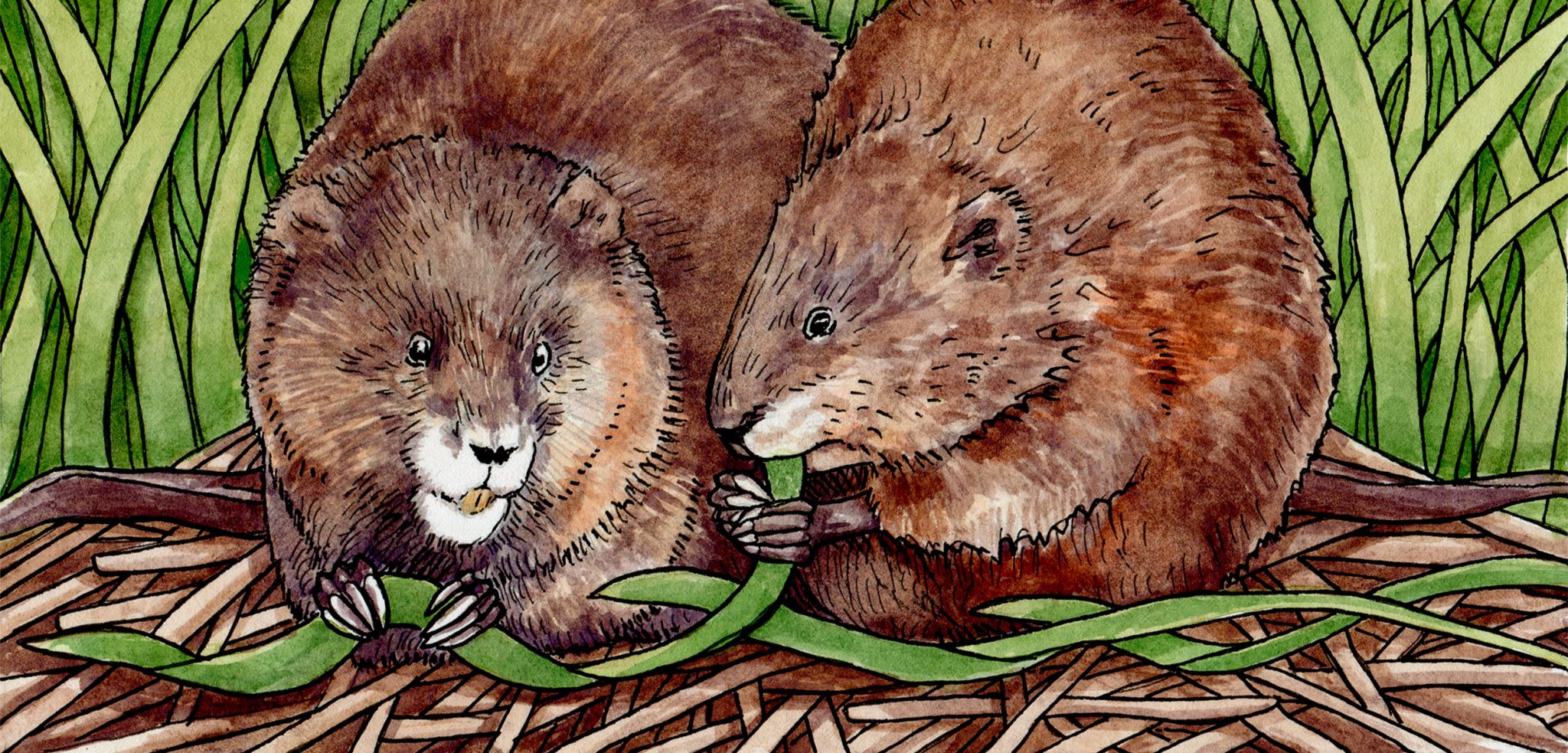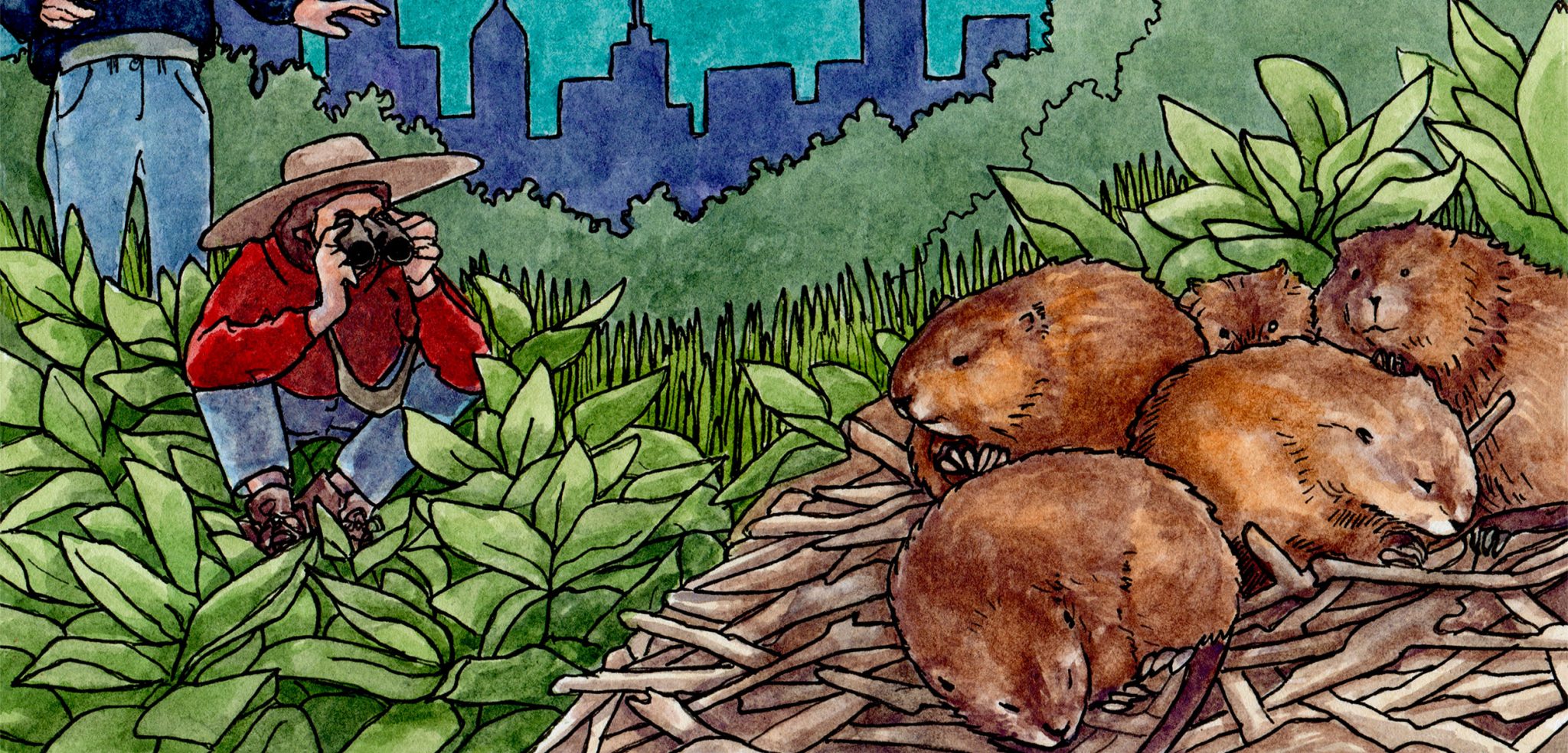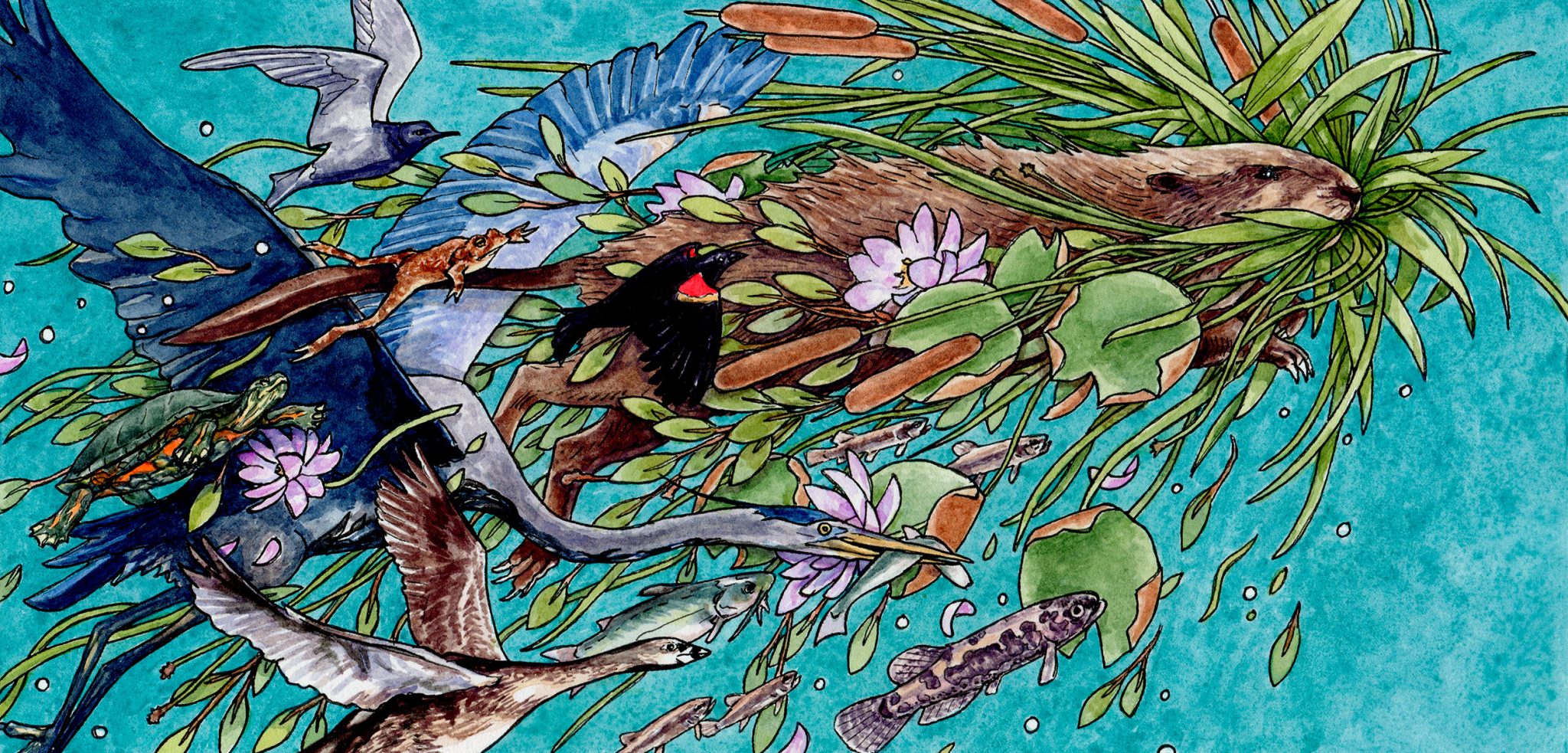I found this article to be a lovely and elegiac read. Also really informative. I was concentrating on our beavers, I never thought much about the little guys, except for cases of mistaken identity.
The Waning Reign of the Wetland Architect We Barely Know (Hint: Not a Beaver)
[Muskrats] are prolific breeders, raising a dozen or more young per year in times of plenty, as happy and quick to set up house along a drainage ditch as in a wetland sanctuary. Even as other so-called furbearers were trapped to near-oblivion in the 19th and early 20th centuries, muskrats flourished, and they persisted through the thoughtless times before the adoption of federal clean water laws and the advent of environmental agencies in the United States and Canada. They’re the sort of species for whom the International Union for Conservation of Nature’s formal designation of “least concern” has seemed quite appropriate. Impervious would be another term.
Yet, reports of declines continued to gather from throughout their native range, which runs from the Arctic Circle to the US–Mexico border. In 2017, biologists Adam Ahlers of Kansas State University and Edward Heske at the University of Illinois Urbana-Champaign published the most comprehensive analysis to date, confirming that the patterns did not seem to be a function of trapping statistics. Something else was going on—and whatever it was, it was big. Since the early 1970s, muskrat populations appeared to have fallen by at least one-half in 34 US states. In a handful of states, the collapse was near-total, coming in between 90 and 99 percent.
I just check my files and I last filmed a muskrat at the secondary dam in 2014. Around 2011 the phragmites taking over. Did they run out of food?
Another possibility is that muskrat habitats are changing in fundamental ways. Not only have many wetlands been lost to or degraded by human activity, but those that remain may be isolated, making it difficult for muskrats to travel between them and establish new homes. The importance of dispersal, as such movements are technically known, is neatly illustrated by research from northern Alberta’s vast Peace-Athabasca Delta, where the density of muskrat houses—the rodents often build mud-and-grass huts, counts of which are used as population proxies—has plummeted by 90 percent since the early 1970s.
I’m pretty sure our muskrats were bank dwellers, I never saw a single grass hut. But I had beavers on the brain.
Researchers also found that hydrological changes did more than reduce the availability of habitat. They altered the dynamics of life in the delta. Muskrats there could be understood not as a single population but as a network of subpopulations who, in isolation, are prone to extirpation during dry periods and as vegetation shifts. Historically, those subpopulations were replenished by new muskrats arriving from elsewhere in the delta via routes created by flooding; but as the floodplain shriveled, so did the network. The now-isolated subpopulations would vanish, one by one, without being renewed—something that might be happening in the wider world, wrote the researchers, not just in the Peace-Athabasca Delta.
The article talks about muskrats moving nutrients on a small scale. In very still ponds they might be the only thing that does.
A long-legged spider perches beside the scat, perhaps attracted by inAAsects who themselves are attracted to its concentration of nutrients. By such increments ecosystems cohere and flourish, and the tableau makes for a small demonstration of a role played by muskrats: they cycle and transport nutrients. That’s not so important on a river like the Blackstone, says Crockett, where nutrients are moved by large-bodied fish—not to mention sewage treatment plants, of which there is one upriver in Woonsocket and another at the Blackstone’s headwaters in Worcester, Massachusetts—but in a wetland where waters are still, he says, muskrats are much more significant.
In a little while, we enter just such a place, a long, shallow basin adjacent to the river’s main stem where the water is still and profuse with emergent vegetation: pickerelweed, arrowhead, reeds, and pond lilies, rimmed by stands of cattails. “In some of these wetlands, what happens within that one little pocket is all that’s ever going to happen,” says Crockett. “If there is or isn’t an herbivore will make a big difference.”
In these places, grazing by muskrats takes up nutrients locked in plants and spreads them around. And not just from plants: when muskrats eat mussels, which they gather and eat in favored dining spots, day after day, they create mounds of discarded shells that are fountains of calcium on the landscape. Their grazing also helps prevent vegetation from becoming so dense that over time it builds up, forms soil, and turns the wetland into land. The scientific name for what muskrats help produce is hemi-marsh: about half vegetation and half open water, a configuration that has coevolved with a menagerie of wetland species.
Ducks use that open water. Light penetrates it, nourishing plankton and in turn small fish and aquatic invertebrates and a different set of subaquatic vegetation, not unlike sunbeams in a forest clearing. Laurence Smith describes how, when muskrats build houses in cattail marshes, they clear a circle some five or six meters across, and then when they depart, the vegetation regrows. The result is a patchwork of variation across time as well as space. “It’s a form of disturbance,” says Smith. “Disturbance is good. Disturbance provides diversity of ages and decomposition on the landscape.”
It’s funny. but I cant be sure of what (if any) changes muskrats made in Martinez. I know what the beavers did, but maybe they did some too.
 In his review of muskrat ecosystem impacts, Ahlers describes how these disturbances produce dramatic increases in plant species richness. One study suggested that muskrats were primarily responsible for an increase of more than 70 percent in the variety of plants found in the disturbed areas of a cattail marsh; by grazing on abundant plants that would otherwise become dominant, muskrats also create space for rare plants to grow. Meanwhile, their houses—a meter or more from the water and up to two meters wide, lasting for a year or two before gradually degrading—become habitat features themselves. “Birds are probably the most conspicuous beneficiaries of the muskrat’s influence on wetlands,” writes Ahlers, including the ducks, terns, grebes, and other wetland avians who use muskrat houses as nesting sites. Turtles, water snakes, and frogs also dwell in them, and even skunks and shrews—more than 60 vertebrate species altogether, by one count.
In his review of muskrat ecosystem impacts, Ahlers describes how these disturbances produce dramatic increases in plant species richness. One study suggested that muskrats were primarily responsible for an increase of more than 70 percent in the variety of plants found in the disturbed areas of a cattail marsh; by grazing on abundant plants that would otherwise become dominant, muskrats also create space for rare plants to grow. Meanwhile, their houses—a meter or more from the water and up to two meters wide, lasting for a year or two before gradually degrading—become habitat features themselves. “Birds are probably the most conspicuous beneficiaries of the muskrat’s influence on wetlands,” writes Ahlers, including the ducks, terns, grebes, and other wetland avians who use muskrat houses as nesting sites. Turtles, water snakes, and frogs also dwell in them, and even skunks and shrews—more than 60 vertebrate species altogether, by one count.
These animals also avail themselves of the reed feeding platforms that muskrats construct. So do beetles and other invertebrates, and in turn their predators benefit. As the platforms decompose, they even increase local microbial diversity. And where muskrats dig dens in banks along the water’s edge rather than build houses, their burrowing aerates riparian soils, and those subterranean chambers become habitat for reptiles and amphibians. “When you remove them,” says Smith of muskrats, “the ecology of the wetland changes.”
I have a tendency to be a little affronted by the credit folks want to give to muskrats. But I guess they do make lots of little differences.
“A loss of muskrats comes with significant costs, many of which we might already be experiencing,” wrote biologists with Ontario’s ministry of natural resources after documenting muskrat house count declines of more than 90 percent in Point Pelee National Park. “A scarcity of muskrats should be considered a red flag for the state of biodiversity in our wetlands.”
I never about them eating freshwater mussels. But given the amount we saw in Martinez this did not surprise me.
 One pattern to emerge from his data and elsewhere is that muskrats have fared just as well in urban as in wilder places. When Smith tested his muskrat DNA detection system, the best locations he found were in cattail-rich wetlands in the city of Providence, one of them downstream from a Superfund site. The Blackstone River was, until not long ago, intensely polluted; an original artery of the Industrial Revolution, its modern contours have been shaped by several centuries of intense human activity. Behind the channel where we saw our muskrat was an old sewage treatment plant. The morning’s songbird chorus made itself heard over the din of a nearby quarry and traffic passing overhead on a bridge of Interstate 99, the Woonsocket Industrial Highway.
One pattern to emerge from his data and elsewhere is that muskrats have fared just as well in urban as in wilder places. When Smith tested his muskrat DNA detection system, the best locations he found were in cattail-rich wetlands in the city of Providence, one of them downstream from a Superfund site. The Blackstone River was, until not long ago, intensely polluted; an original artery of the Industrial Revolution, its modern contours have been shaped by several centuries of intense human activity. Behind the channel where we saw our muskrat was an old sewage treatment plant. The morning’s songbird chorus made itself heard over the din of a nearby quarry and traffic passing overhead on a bridge of Interstate 99, the Woonsocket Industrial Highway.
Well if more cities coexist with beavers it will help the muskrats too, right? Go read the entire article, it’s very well written. The lovely illustrations are by Sarah Gilman who is the same woman that did the awesome illustration for Ben Goldfarb’s Eager book.
Makes sense.




 The researchers asked 2,759 4th-through-8th grade North Carolina schoolchildren about the animals they liked most and those they found scary, and to rank their five favorite mammals from a list of 20 local and exotic species. Slightly more than half the students lived in suburban areas, while the rest were exurban or rural dwellers.
The researchers asked 2,759 4th-through-8th grade North Carolina schoolchildren about the animals they liked most and those they found scary, and to rank their five favorite mammals from a list of 20 local and exotic species. Slightly more than half the students lived in suburban areas, while the rest were exurban or rural dwellers.






































